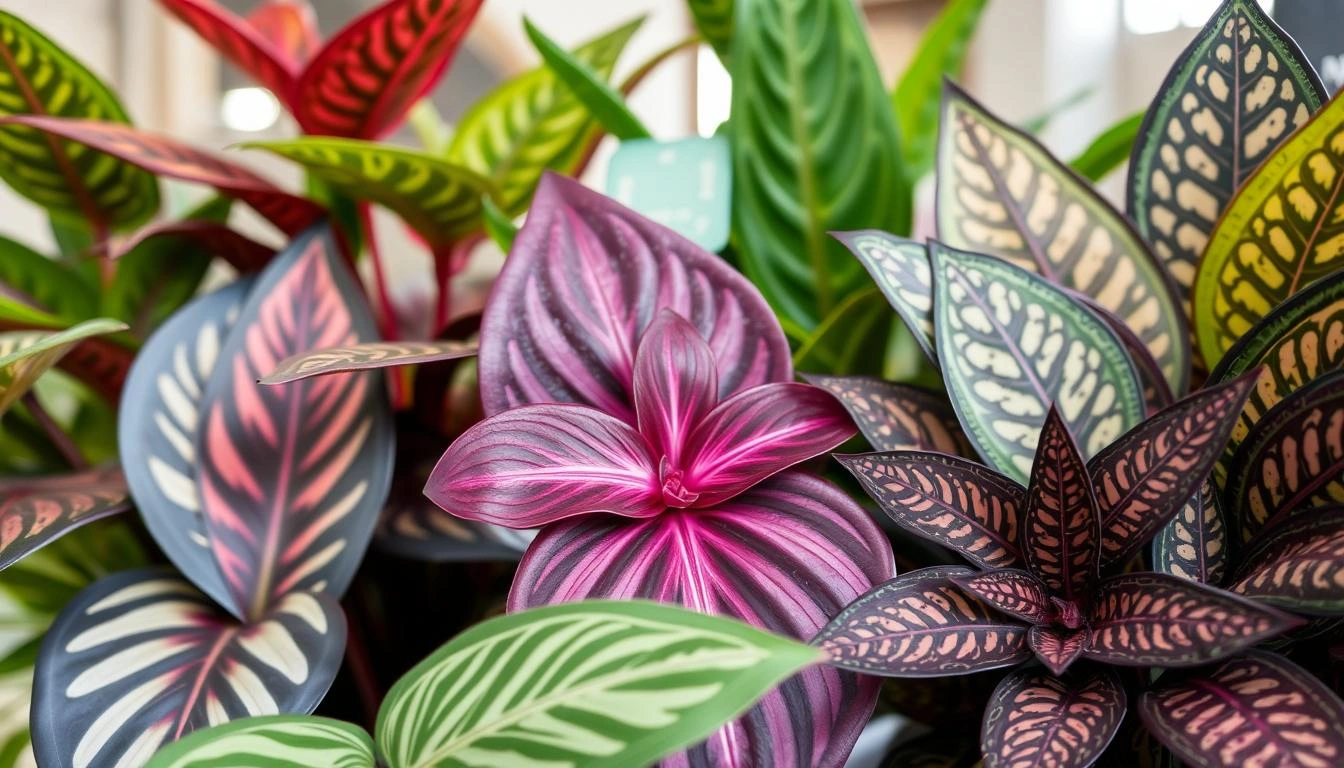“Prayer Plant: 4 Unique Tricks to Care for it”
Are you fascinated by the prayer plant’s (Maranta leuconeura) leaves that fold up at night? They unfurl in the morning. This tropical houseplant is a joy to have, but it needs special care. Learn four clever tricks to keep your prayer plant thriving at home.
Key Takeaways
- Prayer plants are slow growers, typically reaching 6-12 inches tall indoors1
- They are non-toxic to pets and humans, making them a safe choice1
- Prayer plants thrive in warm, humid conditions with well-draining soil1
- Proper watering and lighting are crucial to prevent common issues like yellow or brown leaves1
- Propagating prayer plants through division can help you create new plants2
What is a Prayer Plant?
Botanical Characteristics and Origins
The prayer plant, known scientifically as Maranta leuconeura, belongs to the Marantaceae family. This family has about 50 species and many cultivars3. These plants come from the lush areas of South America4.
They are loved for their unique leaves that fold up at night, looking like hands in prayer. This movement helps the plant get light, keep moisture, and fight off diseases3.
Prayer plants grow up to 12 inches tall and 18 inches wide indoors4. They are slow-growing but add beauty to any room3. With many cultivars, they come in different colors and patterns, like green, burgundy, and more5.
Prayer plants are great for both experienced and new gardeners3. With proper care, they can flourish indoors, enhancing any space with their natural beauty.
Ideal Growing Conditions
Prayer plants love bright to medium indirect sunlight6. They don’t like direct sunlight because it can burn their leaves6. They grow best in warm, humid places, like bathrooms6. A small humidifier can help keep the air just right for them7.
Prayer plants like temperatures between 60-80°F6. They should stay away from cold drafts or sudden changes in temperature6. They do well in potting mixes that drain well and are slightly acidic7. Fertilizing them every two weeks with a weak fertilizer helps them grow strong7.
Give your prayer plant the right light, warmth, and humidity, and it will flourish6. With proper care, it will show off its beautiful leaf movements and stay healthy7.
Watering and Humidity Requirements
Maintaining the Right Moisture Balance
Keeping your prayer plant (Maranta leuconeura) happy means getting the watering and humidity just right. These plants love moist soil but hate being too wet8. From March to September, water them once or twice a week. Let the top inch of soil dry before you water again8. In the fall and winter, you can cut back to watering once a week8.
Use filtered, distilled, or rainwater to avoid harming your plant with tap water minerals8. Too much water can cause root rot, while too little makes leaves turn yellow and fall off8. Keeping the right moisture is key to your plant’s health8.
Prayer plants also love humid air9. They do best in soil that’s always moist and in air with at least 50% humidity9. You can mist their leaves or use a humidifier to keep the air right8.
| Prayer Plant Care Requirements | Optimal Levels |
|---|---|
| Soil Moisture | Consistently moist, but not waterlogged |
| Watering Frequency | Once or twice a week during growing season, once a week in fall/winter |
| Water Type | Filtered, distilled, or rainwater |
| Humidity | At least 50% |
| Temperature | 60-80°F (16-27°C) |
“Maintaining the right moisture balance is crucial for the health of prayer plants.”
By following these watering and humidity tips, you can make sure your prayer plant thrives8910.
Prayer Plant Varieties
The Maranta genus, often called the “true” prayer plant, has many varieties that excite plant lovers11. Each one has unique leaf patterns and colors, making them great for any indoor garden12.
The tri-colored maranta (Maranta leuconeura var. erythrophylla) is very popular. It has bold red veins on green leaves11. Other favorites include the rabbit’s tracks maranta (M. leuconeura var. kerchoveana) with green leaves and darker spots11. The green maranta (M. leuconeura var. erythroneura) has white/lime green veins12. The black maranta (M. leuconeura var. massangeana) has silvery blotches and white veins12.
Prayer plants and calathea plants are related but belong to different families12. The Maranta genus is the “true” prayer plant12. This makes it special compared to its Calathea and Stromanthe relatives.
| Variety | Leaf Pattern | Humidity Needs | Size |
|---|---|---|---|
| Tri-colored Maranta | Bold red veins | 60-80% | 12-18 inches |
| Rabbit’s Tracks Maranta | Green leaves with darker splotches | 60-80% | 6-12 inches, 6-24 inch spread |
| Green Maranta | White/lime green veins | 60-80% | 8-15 inches, 8-18 inch spread |
| Black Maranta | Silvery blotches, white veins | 60-80% | Not provided |
| Calathea Orbifolia | Round leaves with dark green bands | 50-80% | 2-3 feet, 2-3 feet spread |
| Fishbone Prayer Plant | Elongated leaves with dark patterns | 50-80% | 12 inches, 18-24 inch spread |
| Lemon Lime Prayer Plant | Bright green leaves with yellow-green veins | 60-80% | 8-15 inches, 8-18 inch spread |
Whether you like the bold colors of the tri-colored maranta or the subtle beauty of the green maranta, there’s a variety for everyone1112.

Pruning and Propagation
Maintaining Shape and Creating New Plants
The prayer plant (Maranta leuconeura) doesn’t need a lot of pruning13. But, trimming it right can keep it looking good and bushy. The best time to prune is in the spring or summer when it’s growing fast14.
When you prune, use sharp pruners and cut just above a leaf node. This helps the plant grow new leaves and prevents water from causing disease14. Don’t prune too much, as it can stress the plant and stop it from flowering14.
- Prune your prayer plant twice a year to keep it healthy and prevent it from getting too big14.
- Prune for looks, trimming it to your preferred shape and size14.
- After pruning, watch how the plant recovers. Water it well and give it the right food to help it grow14.
Prayer plants can also be split or grown from stem cuttings15. To split the plant, take it out of its pot, shake off dirt, and separate the roots and stems. Make sure each part has enough roots15. Then, put the new parts in a mix of potting soil, perlite, and coco coir15.
Stem cuttings can also grow roots in water or potting mix15. To make a stem cutting, cut just below a node, dip in rooting hormone, and put it in water or mix15. With the right care, roots should grow in three to four weeks15.
By using these pruning and propagation methods, you can keep your prayer plant looking great. You can also make new plants to share or keep for yourself141513.
Common Issues and Solutions
Prayer plants can face some common problems, but they can be fixed with the right care. Yellow leaves often come from too much water, too little water, or not enough light16. To keep your plant healthy, water it when the soil is almost dry. Make sure it gets bright, indirect light16.
Brown leaves or tips can happen from not enough water, low humidity, or too much direct sun16. To fix this, use a humidifier or mist the leaves. You can also move the plant to a spot with better light16.
Leaf dropping can be caused by sudden changes in temperature or humidity, pests, or too much fertilizer16. Keep the environment stable, watch for pests, and don’t over-fertilize17.
If your plant is not growing well or is wilting, it might have root rot from too much water16. Check the roots and repot in a soil that drains well to stop the decay18.
By watching for these issues and fixing them quickly, your prayer plant will do well. Adjust how you water, light, and humidify it. Also, watch for pests. With a bit of care, your plant will show off its beauty161718.,,

Prayer Plant Care Essentials
Looking to brighten up your home with a touch of nature? The prayer plant is a great pick. These plants are safe for pets and love low light, making them perfect for cleaning your air19. Let’s dive into what they need to thrive.
Prayer plants love bright, indirect light. Aim for 6 to 8 hours of it daily19. Keep the soil moist but not too wet20. They also enjoy humid environments, so misting or a humidifier can help19.
For soil, they prefer a slightly acidic to neutral pH, around 6.0 to 7.020. Use a mix that drains well but is rich in nutrients. Feed them monthly with a balanced fertilizer during spring and summer, but dilute it to half strength20. Too much fertilizer can harm them.
Keep your plant healthy by pruning and cleaning. Remove any damaged leaves and gently dust the leaves with a damp cloth19. You can also propagate them through division or stem cuttings20.
With the right care, your prayer plant will flourish. They need the right temperature, humidity, and soil to thrive20. Plus, they’re great at purifying the air, making them a wonderful choice for any home19.
Conclusion
The prayer plant is a stunning addition to any home. It has unique leaf movements, bright foliage, and loves low-light conditions. This makes it a perfect houseplant21.
For a healthy prayer plant, you need the right care. This includes regular watering, high humidity, and some indirect sunlight. With these, your prayer plant will thrive and add beauty to your home21.
Adding a prayer plant to your collection is a great idea. It’s perfect for both new and experienced plant parents. These plants not only look beautiful but also clean the air by removing formaldehyde and benzene21.
The Maranta Prayer Plant is loved by many plant lovers22. Its leaves move up at night, like hands in prayer. This makes it a unique and captivating sight21.
Learning to care for a prayer plant is rewarding. It can turn your home into a green, peaceful oasis22.







